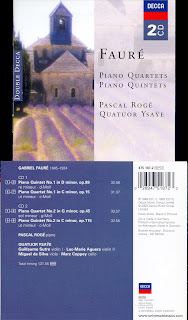This is the first time Pamela Frank's version of Brahms Second Sonata has found its way into my Blog, the other two Sonatas have been discussed before, i don't know why this one got missed, it started off as my favourite Brahms Violin Sonata, though now i like the other two equally, i was only just playing this Sonata earlier in the month by Boris Belkin [6th June 2011], each of the three Sonata's are indelibly Brahms, and yet each has a unique character, in some ways i feel that the second Sonata has an impish character to it.
Pamela Frank is an American Violinist, born in 1967, and recently turned 44, she made this recording in 1996, the visuals [front and back] are excellent, i like colour themes, and this is all orange and black and brown, two separate shots of Pamela Frank [by Julian Barton] and Peter Serkin [by Carol Weinberg], and nicely juxtaposed alongside each other, one a monotone shot [Serkin], and the other a colour shot [Frank], the lettering is excellent also, i really like this cover.
For me the second movement Andante Tranquillo / Vivace, has these two themes, one of course tranquil, the other more agitated, and they both weave in and out of each other, using their contrasts to excite and soothe, the recording is quite bass heavy, and Serkin's piano doesn't go plink, rather a sort of plomb!, it can be dead and non ringing, especially in trebles, you just don't get that sharp zing high in the right hand, however when the first vivace comes along [1:24-2:21], the piano has a nice bubbly blunted legato to it, very fetching, and the violin is nicely virtuosic, in the second slow section, the violin reaches into impassioned heights [3:29-4:10], gently at first, and then stronger and sweeter, and coming back down to earth again, the next fast section is probably the best, with the violin producing lots of pizzicato figures, tremendously excellent alongside the piano, and then right at the end just when you think the movement is going to end on a tranquil note, the pizzicato violin returns for one last showy burst [6:32-6:43], i just love this movements juxtaposing!.
Here's Kyung Sun Lee playing the second movement on YouTube.






